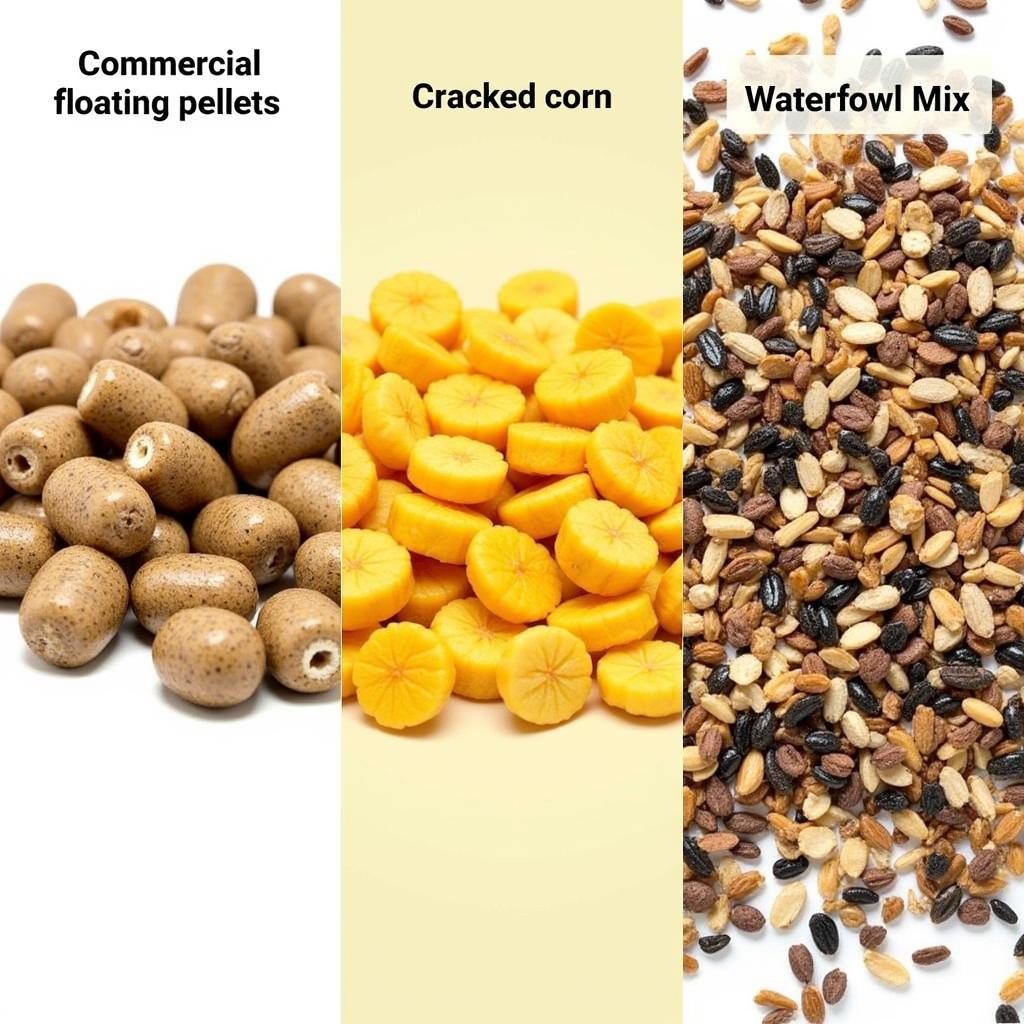Floating Waterfowl Food is crucial for the health and wellbeing of ducks, geese, and swans. Whether you’re a concerned birdwatcher or simply curious about what keeps these feathered friends afloat and fed, understanding their dietary needs is essential. This guide will delve into the world of floating waterfowl food, exploring various options, benefits, and best practices for feeding.
Understanding Waterfowl Dietary Needs
Waterfowl, encompassing a diverse group of birds adapted to aquatic environments, require a balanced diet to thrive. Their nutritional requirements vary depending on the species, age, and time of year. For example, breeding ducks need a higher protein intake, while molting waterfowl require more nutrients for feather regrowth.
The Importance of Balanced Nutrition
Just like humans, waterfowl need a variety of nutrients, including proteins, carbohydrates, fats, vitamins, and minerals. A deficiency in any of these can lead to health problems, affecting their growth, reproduction, and ability to survive harsh weather conditions.
- Proteins: Essential for muscle development and egg production.
- Carbohydrates: Provide energy for daily activities.
- Fats: Crucial for insulation and energy storage.
- Vitamins & Minerals: Support various bodily functions and overall health.
 Balanced Waterfowl Diet: A mix of grains, seeds, and greens ensures proper nutrition for ducks, geese, and swans.
Balanced Waterfowl Diet: A mix of grains, seeds, and greens ensures proper nutrition for ducks, geese, and swans.
Natural Food Sources
In their natural habitats, waterfowl forage for a variety of food sources, including aquatic plants, insects, crustaceans, mollusks, and small fish. These natural foods provide a balanced diet that meets their nutritional needs.
Types of Floating Waterfowl Food
Commercial floating waterfowl food is readily available and offers a convenient way to supplement the natural diet of waterfowl. These specialized feeds are formulated to provide essential nutrients and are designed to float on the water’s surface, mimicking the natural foraging behavior of ducks and geese.
Commercial Floating Pellets
Floating pellets are a popular choice, offering a complete and balanced diet in a convenient form. These pellets are often fortified with vitamins and minerals to ensure optimal health.
Cracked Corn
Cracked corn is a readily available and affordable option. It provides carbohydrates for energy, but it lacks the essential proteins and other nutrients found in a complete diet.
Waterfowl Mixes
Waterfowl mixes combine various grains, seeds, and sometimes dried insects or crustaceans, offering a more diverse and nutritious option compared to cracked corn alone.
 Floating Waterfowl Food Options: Comparing commercial pellets, cracked corn, and waterfowl mixes.
Floating Waterfowl Food Options: Comparing commercial pellets, cracked corn, and waterfowl mixes.
Best Practices for Feeding Waterfowl
While supplementing the diet of waterfowl can be beneficial, it’s crucial to follow best practices to avoid potential harm.
Avoid Overfeeding
Overfeeding can lead to uneaten food accumulating in the water, contributing to pollution and attracting unwanted pests. Feed only what the waterfowl can consume within a short period.
Choose the Right Location
Select a clean and accessible area for feeding. Avoid areas with heavy boat traffic or other disturbances.
Consider the Season
Adjust the amount and type of food based on the season. Waterfowl have different nutritional needs during breeding, molting, and winter months.
Don’t Feed Bread
Bread offers little nutritional value and can cause digestive problems for waterfowl. It can also contribute to water pollution and encourage unhealthy dependence on human handouts.
“Overfeeding can create an unhealthy dependence on human handouts and disrupt the natural foraging behaviors of waterfowl,” warns Dr. Emily Carter, a leading ornithologist specializing in waterfowl ecology. “It’s essential to feed responsibly and prioritize the long-term health of these birds.”
Conclusion
Floating waterfowl food plays a vital role in supporting the health and wellbeing of these fascinating birds. By understanding their dietary needs and following best practices for feeding, we can contribute to their conservation and ensure they continue to thrive in our waterways. Remember to choose nutritious food options, avoid overfeeding, and prioritize the long-term health of these feathered friends.
FAQs
- What is the best floating waterfowl food? A balanced commercial pellet or waterfowl mix is generally the best option.
- Can I feed ducks bread? No, bread is not recommended as it offers little nutritional value and can be harmful.
- How much should I feed waterfowl? Feed only what they can consume within a short period, avoiding overfeeding.
- When is the best time to feed waterfowl? Feeding can be done year-round, but adjust the amount and type of food based on the season.
- Where should I feed waterfowl? Choose a clean and accessible area, away from disturbances.
- Why is floating food important for waterfowl? It mimics their natural foraging behavior and prevents food from sinking and polluting the water.
- What are the signs of a healthy waterfowl diet? Healthy waterfowl will have bright eyes, smooth feathers, and be active and alert.
For further assistance with waterfowl care and feeding, please contact us at Phone: 02437655121, Email: minacones@gmail.com or visit us at 3PGH+8R9, ĐT70A, thôn Trung, Bắc Từ Liêm, Hà Nội, Việt Nam. Our customer service team is available 24/7. We also have a wealth of information available on our website, including articles on “Creating a Waterfowl-Friendly Backyard” and “Identifying Common Waterfowl Species”.